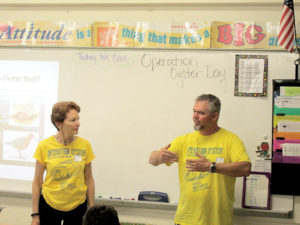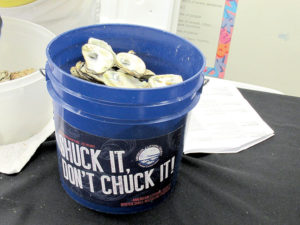Forrestdale students get up close and personal with the filter feeders |
By John Burton |
RUMSON — “How often does an oyster get to come into their classroom?” asked Tim Dillingham, executive director of the American Littoral Society.
For the fourth-to-eighth-grade students at Forrestdale School, Thursday, Oct. 12 was a day to learn about oysters and their role in the ecosystem of the Two River area, and even eat one, if they dared.

As part of its “Operation Oyster” program, the American Littoral Society environmental organization partnered with Forrestdale School, 60 Forrest Ave., to incorporate environmental education and advocacy into the school’s curriculum. Last Thursday was the kick-off day, explained district Superintendent of Schools John Bormann, as educators worked with the environmental group and others to establish an “overall concept” that crosses educational disciplines, and possibly beyond.
“We’ve reached out to different organizations to expand it beyond the classroom,” Bormann said.
During the course of the daylong program last week, students were introduced to all sorts of information regarding oysters. They learned about the bivalve’s history in the Navesink and Shrewsbury rivers, their importance to the culture and economy, as well as the area’s ecology. Students participated in projects and listened to lectures in their math, science and history classes. They contributed writing assignments for English classes.
In one science class, Bormann explained, the kids learned how to construct an oyster reef, providing a home for the shellfish and their contribution to help clean the waterways. In math classes, students were calculating the species’ survivability. A writing assignment had students composing letters to Rumson Mayor John Ekdahl, asking for support from the local government for the environmental group and school’s efforts. As part of their social studies classes, the kids heard from Pati Githens, an educator with the Monmouth County Historical Association, who described the history of the region while wearing a Colonial period costume; and from the historical society’s interim executive director, Chuck Jones, who offered an overview of the oyster population’s decline over the years and its importance in society over the centuries.
The English class offered students a chance to eat an oyster, courtesy of Doug Douty, who owns and operates the Lusty Lobster seafood distributor in Highlands. Douty is an American Littoral Society Board of Trustees member.
Colleen Doogan, director of education for Project Write Now, an independent educational resource, said, “We’re working with the students to help them write about a first-time experience,” in this case tasting an oyster, and “helping them get their thoughts down on paper.” Students were encouraged to write free verse poems about the experience.
Seventh-grader Julianna Fallon offered her take on the first-time taste. “It’s not that good,” the 12-year-old said with a grimace. “It was too salty.”
On the other hand, Douty noted that a few students came back for seconds.
“The idea is to show them the real-world application,” said seventh-grade science teacher Jennifer Crow, “especially as it relates to their backyard.”
“We’re hoping to get them to realize all this stuff is connected,” said Laurie Bratone, American Littoral Society development director.
The society’s executive director, Tim Dillingham, provided students with an outline of how state environmental legislation gets made into law, and offered instructions on writing to local and state lawmakers to voice support on issues. The American Littoral Society is lobbying for legislation that would encourage oyster shell recycling, using the motto “Shuck It, Don’t Chuck it.”
“Part of it is to encourage them to be responsible stewards of their community,” Dillingham said.
Over the course of the school year, students and educators will continue to work with the society, Monmouth University and other groups on this and related projects, providing some field trips to the area’s river shore line, Bormann said.
For the American Littoral Society, this is a pilot program that will likely lay the foundation for programs in other school districts. “The long game,” Dillingham said, “is to teach as many people as we can, as many schools as we can.”

“We’re also very much about empowering them to be good stewards of their backyards,” he added.
The American Littoral Society and other environmental groups have been working aggressively to re-establish oyster beds in area waterways. Oysters work as natural filtration systems, helping remove contaminates from the water. Their beds serve a function, too, acting as a natural tidal break, protecting shorelines, environmentalists have long stressed.
Oysters flourished in area waters until over-harvesting, industrialization and development took its toll by the early 20th century.
This article was first published in the Oct. 12-19, 2017 print edition of The Two River Times.














